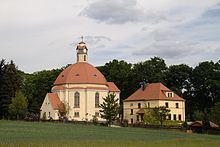Kirschau
|
Kirschau
City of Schirgiswalde-Kirschau
|
|
|---|---|
| Coordinates: 51 ° 5 ′ 32 " N , 14 ° 25 ′ 43" E | |
| Height : | 250 m |
| Area : | 6.52 km² |
| Residents : | 2397 (Dec. 31, 2010) |
| Population density : | 368 inhabitants / km² |
| Incorporation : | January 1, 2011 |
| Postal code : | 02681 |
| Primaries : | 03592, 035938 (Rodewitz / Spree) |
Kirschau ( Sorbian ) is a place in the Saxon district of Bautzen , 8 km south of the large district town of Bautzen . It was an independent municipality until December 31, 2010 and has belonged to the city of Schirgiswalde-Kirschau since then .
geography
Kirschau is located in the Lausitzer Bergland , embedded in the valley of the Spree and Pilke , between the Mönchswalder Berg (449 m) and the Lärchenberg (354 m).
The place is bordered by Großpostwitz in the north, Crostau in the east, Schirgiswalde in the south and Wilthen in the west.
Local division
The following districts belong to Kirschau:
- Bederwitz (Sorbian Bjedrusk ), 119 inhabitants
- Kirschau ( Korzym ), 1761 Ew.
- Kleinpostwitz ( Bójswecy ), 58 Ew.
- Rodewitz / Spree ( Rozwodecy ), 450 Ew.
- Sonnenberg ( Słónčna Hora ), 46 Ew.
history

In 1352 Kirschau was first mentioned in a document in connection with the destruction of Körse Castle . When Upper Lusatia came to Saxony with the Peace of Prague in 1635 during the Thirty Years' War , Kirschau became a border town. A customs post to neighboring Bohemia was established.
Up until 1845 Kirschau was an inconspicuous and poor village. Initiated by Gotthelf August Friese, an important coarse yarn industry developed in Kirschau in the middle of the 19th century. In addition to packing canvas and abrasive cloths, it was colorful blankets that gave Kirschau an unexpected economic boom from the turn of the century. Other branches of industry also settled in the following period. Because of the rising prosperity, Kirschau was called "the village with the golden roofs". The splendid town center and the numerous manufacturers' villas are still reminiscent of this heyday.
For his statistics on the Sorbian population in Upper Lusatia, Arnošt Muka determined a population of 600 inhabitants in the 1880s; 490 of these were Germans (82%) and 110 Sorbs (18%). At that time, Kirschau was on the extreme southern edge of the Sorbian settlement area. The Sorbian language has now disappeared from everyday life.
After the end of the Second World War , the local businesses became public property. The most important company was the merger of several textile companies, the VEB Vegro Kirschau. Through the production of abrasive cloths, carpets and, last but not least, the famous Kirschau blankets, Kirschau became known far beyond the borders of the GDR . Another important company was the gear factory, part of VEB Progress Erntemaschinen Neustadt , which was taken over by GKN Walterscheid Getriebe GmbH and produces cardan shafts .
Since the fall of the Wall in 1989, the Kirschau textile industry has continued to exist on a small scale. Today the year-round bath "Körse-Therme", completed in 1998, is the main attraction for visitors.
On January 1, 1999 Rodewitz / Spree was incorporated.
At the end of 2010, Kirschau lost its independence as a municipality and was connected to the municipality of Crostau and the city of Schirgiswalde to form the city of Schirgiswalde-Kirschau.
Economy and Infrastructure
traffic
The breakpoint Schirgiswalde-Kirschau in the neighboring district of Schirgiswalde is located on the railway line Oberoderwitz-Wilthen and is supported by regional rail line Dresden - Zittau in 2-hour intervals served.
Culture and sights

Museums
Kirschau Castle Museum
- History of the place and the castle Körse
- Heimatstube with working hand loom
Buildings
- Körse castle ruins
- Dreiländerstein on the former border between Wilthen in Meißen , Schirgiswalde in Bohemia and Kirschau in Lausitz (1746).
- Johanneskirche, an evangelical domed church in Art Nouveau, consecrated in 1924 with an extraordinary altarpiece by the painter Bernhard Müller from Dresden
- Kuxloch, an approx. 12 m long legendary old mining tunnel at the foot of the castle hill
- Deutscher Steig, a picturesque piece of a medieval trade route that has been preserved
- Town center with magnificent art nouveau buildings, u. a. the post office with corner turrets and ornate gable
- former manufacturers' villas
- Wagnerwehr, an old hydropower plant
Regular events
- Witches' fire on Walpurgis Night
- Annual Körsesingen on the castle ruins
education
Kirschau has a primary school. The middle school closed in 2003.
Partnerships
Kirschau maintains partnerships with Denkingen and Niederstetten .
Personalities
- Wilhelm Schulze-Rose (1872–1950), painter, spent the last years of his life in Kirschau
- Günter Semjank (1949–1995), teacher, television announcer
literature
- Hermann Knothe : History of the castle and the village of Kirschau, south of Budissin . In: Lausitzisches Magazin. On behalf of the Upper Lusatian Society of Sciences . Volume 47, Görlitz 1870, pp. 293-295.
- Cornelius Gurlitt : Kirschau. In: Descriptive representation of the older architectural and art monuments of the Kingdom of Saxony. 31. Booklet: Bautzen Official Authority (Part I) . CC Meinhold, Dresden 1908, p. 99.
Web links
- Kirschau in the Digital Historical Directory of Saxony
Individual evidence
- ↑ General artist lexicon. The visual artists of all times and peoples. Vol. 12. Saur, Munich / Leipzig 1996, p. 285.
- ↑ Information from the registration authority Verwaltungsgemeinschaft Schirgiswalde; As of December 31, 2009
- ↑ Ernst Tschernik: The development of the Sorbian population . Akademie-Verlag, Berlin 1954, p. 54 .
- ↑ StBA: Changes in the municipalities in Germany, see 1999


